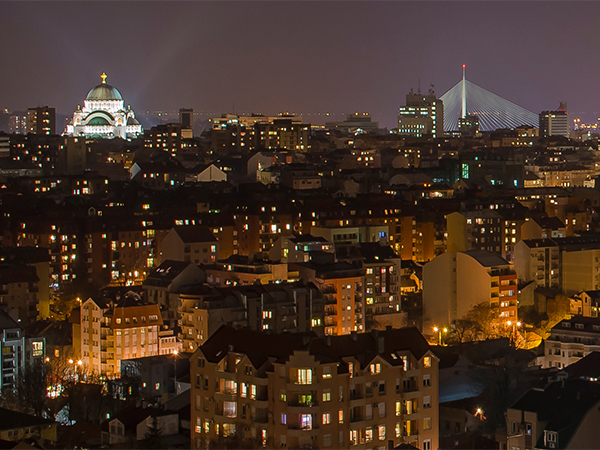Belgrade: Affordable Dentistry Dental Destination

Belgrade is the capital and largest city of Serbia. It is located at the confluence of the Sava and Danube rivers, where the Pannonian Plain meets the Balkans. Its name translates to "White city".
In Belgrade, Serbia's capital and major city center, there is plenty of things to do to satisfy any age or taste, whether it is having a meal at an open air café before visiting a museum or checking out local artists working at the many exquisite galleries, both indoors and out, to be found throughout the country.
Besides the fun activities, Belgrade is also known for low dental treatment costs and friendly, welcoming English speaking staff. Belgrade is really a combination of "business" and pleasure.
Spend your holidays in Belgrade, where beside having a good time you can get any dental treatment that you need for a price that is more than reasonable. Dentist are highly qualified and are up-to-date with their knowledge, materials and equipments used are from known brands.
Belgrade at night
There are winter and summer Belgrade clubs.
Winter nightclubs are located downtown, and their busy season stretches from October through May.
In the summer, Belgrade party moves to the rivers, where summer nightclubs have their opening nights in May. Actually, those are big, open-air rafts and boats, remodeled into discotheques. The most popular Belgrade clubs are those on the river Sava, starting from the old Railway Bridge and up to the “Gazela” bridge, and also those on the Danube, near “Hotel Yugoslavia”.
Belgrade nightclubs don’t practice cover charge, but the reservation is necessary. All spots – by the bar, bar tables, high tables, VIP tables – are bound to be reserved. It is very important to get into the club no later than half past midnight, because otherwise the club has the right to give your reservation to someone else.
Also, in nightclubs in Belgrade you can’t enter inappropriately dressed (like: sports fashion), and you can’t carry drinks, narcotics or weapons inside. Besides that, bouncers at the gate are checking if your name is on the list of guests.
Fascinating Facts about Belgrade
- Belgrade rests on the remains of an ancient city - Today there isn’t a single location in old town Belgrade that doesn’t hide remnants from the Roman period! In fact, the first urban settlement was built here in the 3rd century BC by the Celts. It was then conquered by the Romans in the 1st century BC and named Singidunum.
- Vinča, a culture older than the Mesopotamian - Belgrade is one of the oldest cities in Europe with settlements continuously existing here for at least 7000 years. Not far from Belgrade center resides a culture older even than the settlements in Mesopotamia.
- One city – fifteen names - With the Celts naming their settlement Singidūn(on), Belgrade went from that to Singidūnum, and since then it has been known by many names including: Alba Graeca, Alba Bulgarica, Fehérvár, Nandoralba, Nándorfehérvár, Landorfehérvár, Weißenburg and Griechisch-Weißenburg, Castelbianco, Veligrad(i)on or Velegrada, Dar Al Jihad (House of War), Belgrat, Prinz Eugen Stadt. But the name that stuck to this day is Beograd (The White City), mentioned for the first time in 878 in a Papal letter to the Bulgarian ruler Boris I.
- A cave in the middle of the city - In the city centre, beneath the church of Saint Mark’s on Tašmajdan there is an actual cave. The Šalitrena cave was used in the Roman period to excavate a type of stone mostly used to make sarcophaguses (which have later been unearthed all over Belgrade).
- Kalemegdan, the legendary Attila’s grave? - In the 5th century, the Belgrade fortress was destroyed by the Huns and in the early Middle Ages saw an onslaught of Barbarian tribes, including the Slavs. A legend even says that Attila’s grave lies at the confluence the Danube and the Sava river, more precisely under the very fortress. Once Kalemegdan was a fortress (kale) and a field (megdan), and now it is one of the most important cultural-historic sites, a park and a playground, a lookout and a Zoo, a concert venue and so much more.
- In Belgrade, there’s a city underneath the city - Belgrade has so many secrets, but one of them hides inches below the surface. Literally. More than one hundred caves, canals, tunnels, passages tell the story of its connection to various empires and states that ruled here over the ages. As such, underground Belgrade has always attracted tremendous attention. Roman halls and aqueducts, Tito’s secrets as well those of Communist Information Bureau spies – you can find them all beneath Belgrade.
- The depths of the legend-laden Roman well - One of the major Belgrade attractions is most certainly the Roman well with its two spiral sets of 212 steps. This well is 62 metres deep, which is 10 metres deeper than Belgrade’s lowest point, and full of mysteries. As the legends regarding the well started to get mixed up over time, some people now believe that the two skeletons found in the 1960’s were the remains of the Austrian traitors that were left to kill each other, while others believe that these were the bodies of German treasure hunters.
- A major Mason meeting place - The existence of Freemasonry has been one of the biggest and best-kept secrets for centuries now. But Masons have reached Serbia. In fact, a lot of buildings in Belgrade bear the symbols of freemasonry. Even more interestingly, the tomb of Branislav Nušić was built in the shape of freemasons’ unfinished pyramid and on the tomb of Živojin Mišić there’s another of their symbol – an acacia branch.
- Belgrade has its own silicon valley - However, it has absolutely nothing to do with computers or technology. The Strahinjića Bana Street is popularly called the Silicon Valley because of the cosmetically enhanced attributes of the women who like to visit the many bars and restaurants of this Belgrade neighbourhood.
- The first kafana in Europe - We all know and love kafanas, but do you know when and where the first one ever was opened? According to many historians, the first kafana in Europe was opened in Dorćol in 1522.
- Duck hunting on the city square - One of the many peculiar and quirky traditions of Belgrade that rarely who knows is that during the early 19th century the Slavija square had been a famous hunting ground. The property was bought in 1878 and owned by a Scotsman called Francis MacKenzie. The locals used to gather here and go hunting for wild ducks.
- The home largest Orthodox cathedral - The Church of Saint Sava on Vračar is one of the most recognizable symbols of Belgrade. Its dome is 70 metres tall and on top of it is a 12 metre high gold-plated cross. With it reaching a height of 87 metres in total, this Cathedral represents one of the largest churches in the world and the largest church building in the Balkans.
- The White Fenix: razed to the ground 44 times - If we told you that Belgrade had been fought over in 115 wars and razed to the ground 44 times, would you believe us? Well, it’s true! Because of its strategic location at the confluence of the two rivers, the White city found itself at the intersection of Western and Oriental Europe. Due to this, its history left it no choice but to be conquered by the Celts, Romans, Goths, Huns, Ottomans, and then fought over by the Ottoman and Austro-Hungarian Empires. But Belgrade always “bounced back to its feet”.
- In Belgrade partying is a water sport - Apart from the famous kafanas, surplus of bars, cafes, pubs, clubs, when it comes to party tricks Belgrade has one more ace up its sleeve! Belgraders and their tourist friends party all year round on “splavs” – bars and clubs on permanently moored boats along the banks of the Danube and Sava river.
Getting There
Belgrade Nikola Tesla Airport (BEG), the international airport serves the city.
Where: 226, Beograd, Serbia Call: +381 11 2094000
The main railway station links Belgrade with other European cities and is a viable option for getting to Belgrade from other European countries.
Getting Around
Buses, trams, taxis and trolleys form the public transportation in the city. The railway system connects the suburbs with the urban areas.
Things to Do
The National Museum of Serbia, National Theatre in Belgrade, Zemun, Nikola Pašić Square, The Church of Saint Sava (The Temple of Saint Sava) and the Old Palace (Stari dvor) are sites popular with the visit of tourists and the Avala Monument (Monument to the Unknown Hero/Soldier) on a hilltop from where people can have a glimpse of the city is a must visit site in the city.
Music
Čorba Kafe, this rockin' little joint has live music – from rock and metal to pop and '70s hits – almost every night of the week!
Where: Braće Krsmanović 3, Belgrade
Bitef Art Café, here's something for everyone at this delightful hopscotch of a cafe-club. Funk, soul and jazz get a good airing, as do rock, world music and classical
Where: Skver Mire Trailović 1, Belgrade
Where to Eat
Gradska is Serbian restaurant with authentic national kitchen, so head over to get a taste of Serbia!
Where: Mike Alasa 54, Belgrade Call: +381 11 2928600
Just outside the pedestrian area in the city centre, don't miss Mala Gostionica, this restaurant offers great meat dishes and the prices are very affordable.
Where: Dobracina 6, Belgrade Call: 63300825
Ways to Pay
The Serbian Dinar is the currency of Serbia.


